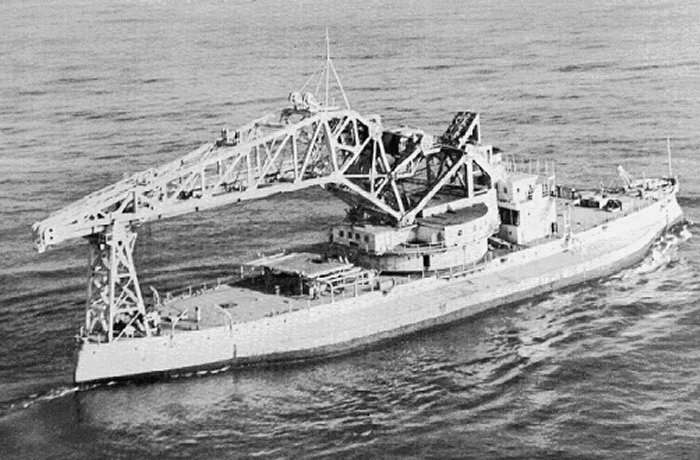Crane Ship No. 1, formerly known as the USS Kearsarge, was repurposed by the U.S. Navy in 1920 to serve as a heavy-lifting vessel for naval shipyard operations.

With its substantial crane, the ship played a pivotal role in moving and placing heavy equipment, such as turrets, guns, and armor, aiding in the construction and repair of numerous naval vessels.
The vessel’s versatility underscored the Navy’s adaptability, and it remained in service until 1955, after which it was sold for scrap.
USS Kearsarge
The dawn of the USS Kearsarge (BB-5) was set against a backdrop of technological advancements and geopolitical maneuvers in the late 19th century.
When the ship was launched in 1898, it was considered a hallmark of modern naval engineering and a tangible representation of the United States’ aspirations to be a global maritime power.
The USS Kearsarge was christened as the lead ship of its class, standing alongside its sister ship, the USS Kentucky.
Both were a direct response to a rapidly evolving naval landscape where steel and steam replaced wood and sail.
The name “Kearsarge” wasn’t chosen arbitrarily; it carried the weight of naval history.
The original USS Kearsarge, a sloop-of-war from the Civil War era, had garnered legendary status by besting the Confederate ship CSS Alabama. This new incarnation was expected to live up to that legacy.
 USS Kearsarge in Brooklyn Navy Yard, 1899.
USS Kearsarge in Brooklyn Navy Yard, 1899.
The design of the Kearsarge was emblematic of the era’s battleship architecture.
The tumblehome hull — where the width of the ship narrows as it rises above the waterline — was a distinctive feature of this time.
This design not only enhanced the ship’s stability but also reduced the target area for enemy gunfire.
Armed with an imposing primary armament of four 13-inch guns housed in dual turrets, the USS Kearsarge was a formidable threat on the high seas.
Its secondary armament further reinforced its dominance, featuring four 8-inch guns and an array of fourteen 5-inch guns.
But the Kearsarge wasn’t only about firepower. Equipped with cutting-edge steam engines, the ship could attain speeds of up to 16 knots — a significant achievement for a vessel of its size and armament.
USS Kearsarge Early Service
During World War I, the USS Kearsarge had already entered the later stages of its service life, and as such, its role had evolved from its earlier days of assertive naval presence and deterrence.
By the time the U.S. entered the war in 1917, naval warfare was undergoing significant changes, with newer ship designs, the emergence of submarines, and the increasing importance of naval aviation.
Given these changing dynamics, older battleships like the Kearsarge were allocated different roles.
By the time of World War I, the USS Kearsarge was primarily used for training purposes.
As the U.S. geared up for the war, there was an urgent need to train a large number of naval personnel quickly.
The Kearsarge, with its extensive facilities and seasoned crew, played a key role in this endeavor.
Cadets and new naval recruits would be trained in various naval operations, including gunnery exercises, ship maneuvers, and other essential maritime activities.
 USS Kearsarge after a refit in 1916.
USS Kearsarge after a refit in 1916.
Additionally, ships like the Kearsarge were used for coastal defense. With the threat of German U-boats and other enemy naval assets, having older but still formidable battleships patrolling the U.S. coastlines provided an added layer of defense and deterrence.
While primarily delegated to training roles, the Kearsarge wasn’t entirely removed from active service.
However, its direct involvement in combat operations during the war was limited, given the changing nature of naval warfare and the presence of newer, more advanced ships in the U.S. fleet.
With the war’s conclusion in 1918, the rapid pace of naval technological advancement became even more apparent.
Battleships like the USS Kearsarge were becoming increasingly obsolete.
Recognizing this, the U.S. Navy began decommissioning and repurposing some of these older vessels.
Transformation Into Crane Ship No. 1
The shifting dynamics of naval warfare and rapid technological advancements after World War I left many older battleships, including the USS Kearsarge, facing obsolescence.
However, recognizing the potential utility of these vessels, the U.S. Navy embarked on innovative projects to repurpose them for alternative uses.
One of the most notable transformations was that of the Kearsarge into a crane ship in 1920.
 USS Kearsarge as Crane Ship No.1.
USS Kearsarge as Crane Ship No.1.
On November 6, 1941, the Kearsarge was rechristened as Crane Ship No. 1. This change allowed its original name to be reassigned to Hornet (CV-12) and subsequently to Kearsarge (CV-33).
Despite the renaming, she persistently served the Navy, facilitating the movement and placement of heavy equipment such as guns, turrets, and armor for ships including the Indiana, Alabama, Savannah, Chicago, and Pennsylvania.
 Crane Ship No.1 at sea in 1944.
Crane Ship No.1 at sea in 1944.
In 1945, she was relocated to the San Francisco Naval Shipyard. Here, she played a role in the building of the Hornet and Boxer and took part in the refurbishment of the Saratoga.
Among her final assignments was assisting in the reassembly of another crane vessel, YD-171 (formerly Schwimmkran nr. 1), located on Terminal Island.
By 1948, she was moved to the Boston Naval Shipyard. Her service officially concluded when she was delisted from the Naval Vessel Register on June 22, 1955, and she was subsequently sold for dismantling on August 9.
What happened to the USS Kearsarge?
The LHD-3 USS Kearsarge is still in active service in the USA Navy but the other USS Kearsarge are not. Actually, this Wasp-class ship shares its name with four other older ships.
In fact, these ships are named in honour of the 1861 USS Kearsarge. As for the fates of the other USS Kearsarge, they were either wrecked, scrapped, or preserved in museums.